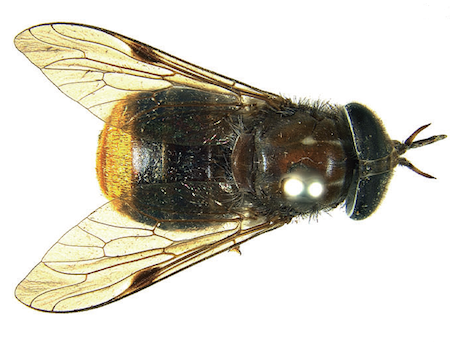A Fly Girl: Black Sexual Politics and Beyoncé
By David J. Leonard and Kristal Moore Clemons
A newly discovered horse fly by Australian scientist Bryan Lessard has become global media fodder. While usually not a source of news, Lessard’s entry into the public square has little to do with the scientific importance of his “discovery,” but rather the chosen name he’s given this new species: Beyoncé. Describing this new species as “bootylicious” because of its “golden-haired bum,” Lessard, a 24-year-old researcher at Australia’s Commonwealth Scientific and Industrial Research Organization writes, Beyoncé would be “in the nature history books forever…[the fly now bearing her name is] pretty bootylicious [with its] golden backside.” He further explained that his name choice came about because the fly was the “all time diva of flies.”
Why would Lessard hope Beyoncé would take this particular scientific discovery as a kind gesture? Does he really think this is a compliment? While we cannot talk about intent, nor are we interested in the reasons behind the naming, we do think it is important to reflect on the larger history at work.
 Popular media has covered the story as cute, as an odd story–one that “honors her”–and as evidence of the global popularity of Beyoncé. For example, Jennifer Walsh, a science writer on MSNBC, discussed naming as a common practice within the science world, noting “Beyoncé’s” arrival with a pantheon of other famous people:
Popular media has covered the story as cute, as an odd story–one that “honors her”–and as evidence of the global popularity of Beyoncé. For example, Jennifer Walsh, a science writer on MSNBC, discussed naming as a common practice within the science world, noting “Beyoncé’s” arrival with a pantheon of other famous people:
Beyoncé isn’t the first celebrity to be honored with her own species. Traditionally named after scientists involved in their discovery, organisms have also been linked to the likes of Harrison Ford, Matt Groening (creator of “The Simpsons”), Mick Jagger and other celebrities, including a beetle named after Roy Orbison.
Considering the lack of media attention to these other named organisms, the comparison is limited at best. More importantly, the very situations and very different histories behind each further highlights the problematic comparison. Did the names of the other organisms reinforce, reduce or play upon longstanding racial fantasies and stereotypes that have been used to dehumanize, mock and ‘color’ black women? Worse yet, did the stories about those other celebrities come with pictures that further reduced their namesakes to a singular body part as a source of juxtaposition?
Several websites paired the story with a picture of Beyoncé that fixated the gaze on to her body (examples #1, #2, #3, #4), thus further sexualizing her through the juxtaposition of her body and that of the fly. Did these other “celebrity names” elicit racist and sexist commentary that included conversations about their breasts and backside; that compare Beyoncé to Michelle Obama through troubling language? Did any of them offer anything close to the the following:
These comments point to an embedded history and a multiplicity of signified meanings, which are in operation here. Thus, while others may say this is innocuous or a celebration of Beyoncé, we don’t view this as complementary or something playful. Rather, it is little more than a continuation of the larger historical narrative. It is the embodiment of Imani Perry’s insightful discussion of the simultaneity of racism and commodification:
The love of black culture with the simultaneous suspicion and punishment of black bodies is not unusual (Perry, p.28).
And whether or not Lessard is a fan, loves Beyoncé or black culture, is irrelevant considering the larger context. Read against history, and read through a prism of the persistent demonization of black women’s bodies, this is yet another instance where representations of black female bodies are under attack. Lessard’s inclination to name this “golden-haired bum” insect after Beyoncé is a throwback or a longing for a racist past when bodies of black women were commodities; available to anyone white who could afford to pay the price. It reminds us of the perverse reality of our society’s obsession with black women’s buttocks and makes us wonder, “is this a perpetuation or reenactment of Sarah Bartmann’s troubling story in the twenty-first century?”
Bartmann, know as “Hottentot Venus,” was a South African woman whose body was put on display in London and Paris in 1816. While in Europe, she was locked in a cage and forced to rock back and forth to emphasize her “wild and dangerous nature”–and “big” black behind (Collins 2004). To onlookers, Bartmann’s body was a sign of racial differences, which supported ideas of black inferiority. While “performing,” she was forced to endure prodding and poking as people tried to understand for themselves, up close and personally, whether or not her buttocks was “normal” or a freak of nature. From Bartmann to Josephine Baker to contemporary video women, it is important to read the scientific hearing (and cultural production) within a larger history. None of this is innocent. Think about the recent comments about Michelle Obama, the fixation on Serena Williams’ body, the national panic over Janet Jackson breast, and the racist demonization of black women in Psychology Today.
bell hooks (1992) is insightful here. She offers a powerful reading of black female sexuality within the American marketplace, demonstrating how the history of black representation and its inclusion within popular culture is a story of hypersexualization and fetish, contempt and surveillance, and a “selling hot black pussy.”
As we enter the dessert place, they all burst into laughter and point to a row of gigantic chocolate breasts complete with nipples – huge edible tits. They think this is a delicious idea – seeing not connection between this racialized image and the racism expressed in the entryway. Living in a world where white folks are no longer nursed and nurtured primarily by black female caretakers they do not look at these symbolic breasts and consciously think about ‘mammies.’ They do not see this representation of chocolate breasts as a sign of displaced longed for racist past when the bodies of black women were commodities available to anyone white who could pay the price (p. 61-62).
In view of this, Lessard is merely selling his “discovery” through an exotic narrative that names black femininity as little more than body parts–little more than objects of gaze and derision. Given that “white Americans have been repulsed by a black sexuality that they redefined as ‘uncivilized,’” (Collins 2004, p. 101) naming an exotic/foreign/mysterious horse fly after Beyoncé, because of their supposed shared physical features, is clearly steeped in racist historical biases about black female sexuality that run deep in scientific discourse. As bell hooks says, this needs to be openly interrogated and explored…everywhere.
Sander Gilman’s critical work, Black Bodies, White Bodies: Toward an Iconography of Female Sexuality in Late Nineteenth-Century Art, Medicine and Literature reminds us that whites were allowed to sexualize their world by projecting onto black bodies a narrative of sexualization disassociated from whiteness, thus forcing their interpretations of black bodies to serve as “icon(s) for black sexuality in general” (p. 216). bell hooks’ “Selling Hot Pussy” reminds us that this type of sexual exploitation and fragmentation is obviously nothing new. Attention has always been focused on body parts, rather than bodies/humanities as a whole:
Their body parts were offered as evidence of support to racist notions that black people were more akin to animals than other humans (p. 114).
The emphasis on the insect’s “golden-haired bum” also speaks to the serious issues regarding skin color politics. Beyoncé is being used as a template for a new standard of beauty that is rooted in a history of racism and commodification. Just a few weeks ago we saw team light skin and team dark skin hashtags engage in a serious colorism battle over the Internet. Or, take for instance, Beyoncé’s most recent L’Oreal ad. As Beyoncé is reciting her lines, “there’s a story behind my skin, it’s a mosaic of all the faces before it, ” the words African American, Native American, and French pop up on the screen. Is Beyoncé aware of the history of colorism? Selling cosmetics on the strength of her Creole identity furthers complicates the issue.
Our question now becomes, is all this worth it? Naming this insect after Beyoncé articulates the world’s preference for light skin, fair skin, and long hair. The elephant in the room here is disrespectability politics rein supreme and “the global desirability of a Black girl’s ass excuses her allegedly less desirable dark skin complexion, full lips, and kinky hair.”
In a week that saw ample discussions of baby Blue Ivey, and endless discussions about whether or not Jay-Z would continue to use the B-Word, it strikes as a bit odd that little has been made about the dehumanization taking place in certain science laboratories.
As I noted in The Hip Hop Wars, just because your enemy is wrong, it doesn’t make you right. It is quite true that hip-hop has played a starring role in making sexist ideas sexy, visible and funky (Tricia Rose).
Through the power of black music, style, swagger and lyrical creativity, Jay-Z and many other highly successful rappers (e.g, Snoop Dog, 50 Cent and Lil’ Wayne) have expanded the visibility and value of aggressively sexist lyrics. And, frankly, if you want to find openly celebrated sexism against black women, there is no richer contemporary source than commercial, mainstream hip-hop.
It’s time to not only reflect on the dialectics between popular culture/hip-hop and other institutions, but also to simultaneously call out the multitude of efforts that dehumanize, ridicule, and denigrate black women’s bodies. Reflecting on persistent misogyny in hip-hop, Mark Anthony Neal pushes for challenges and interventions that include but don’t limit the conversation and opposition to “the game”:
Mr. 50 Cent isn’t the only thug or pimp in the room; there are more than a few in the White House and at the Pentagon (Neal 2005, p. 147).
As we learned last week, there are also some in Australia…
________________________________________
 David J. Leonard is Associate Professor in the Department of Critical Culture, Gender and Race Studies at Washington State University, Pullman. He is the author of Screens Fade to Black: Contemporary African American Cinema and the forthcoming After Artest: Race and the War on Hoop (SUNY Press). Leonard is a regular contributor to NewBlackMan, layupline, and Urban Cusp. He is a past contributor to Slam, Loop21, The Nation and The Starting Five. He blogs @No Tsuris . Follow him on Twitter @DR_DJL.
David J. Leonard is Associate Professor in the Department of Critical Culture, Gender and Race Studies at Washington State University, Pullman. He is the author of Screens Fade to Black: Contemporary African American Cinema and the forthcoming After Artest: Race and the War on Hoop (SUNY Press). Leonard is a regular contributor to NewBlackMan, layupline, and Urban Cusp. He is a past contributor to Slam, Loop21, The Nation and The Starting Five. He blogs @No Tsuris . Follow him on Twitter @DR_DJL.
 Kristal Moore Clemons is a Black feminist intellectual, scholar activist, and assistant professor in the Division of History and Social Sciences at Tallahassee Community College. Her research and teaching interests are interdisciplinary and include American Studies, Women’s and Gender Studies, and the Social and Cultural Foundations of Education. She earned her PhD in Education from the University of North Carolina at Chapel Hill and a graduate certificate in Women’s Studies from Duke University.
Kristal Moore Clemons is a Black feminist intellectual, scholar activist, and assistant professor in the Division of History and Social Sciences at Tallahassee Community College. Her research and teaching interests are interdisciplinary and include American Studies, Women’s and Gender Studies, and the Social and Cultural Foundations of Education. She earned her PhD in Education from the University of North Carolina at Chapel Hill and a graduate certificate in Women’s Studies from Duke University.





4 Comments